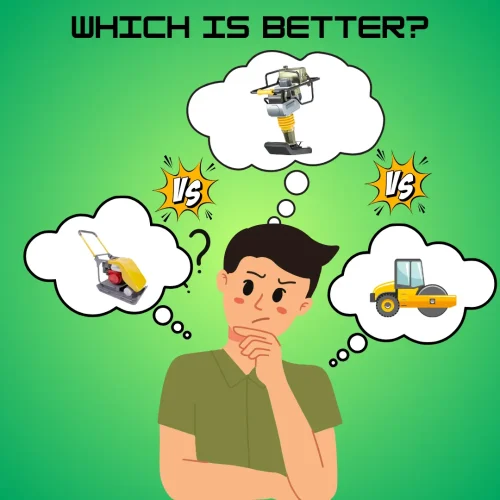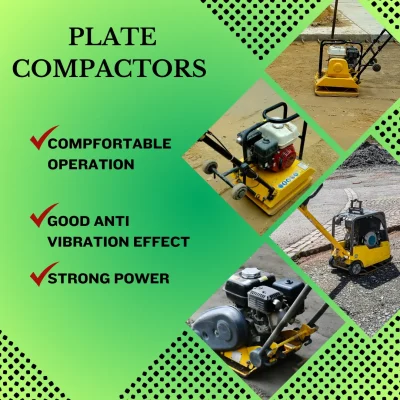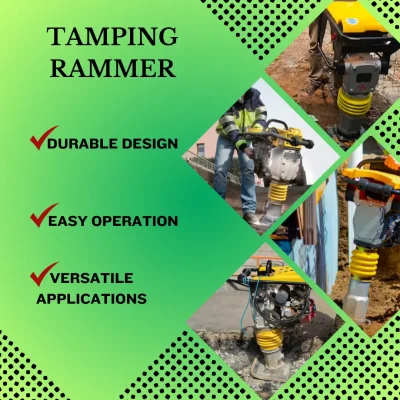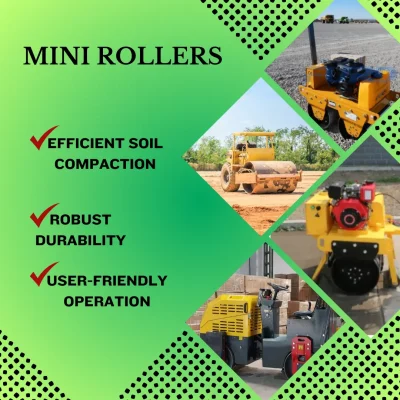The three common types of compaction equipment namely, plate compactors, rammers, and mini rollers are used in the construction industry for proper compaction of soil, asphalt, and other materials to lay a stable and durable base for building projects. For instance, each of these machines is made to do a specific job, based on the kind of material is being compacted, the size of the area, and the project requirements.

This is an in-depth study where we will be exploring the differences between these three compaction tools in detail, which will be done by the following headings. Their design, function, application, advantages, and limitations will be the basis of our focus. As such, you will be able to know the desired specifications to bring out in relation to the three compaction machines and how they can be suitable in the general range of construction machines by the time you finish reading this article.
PLATE COMPACTORS
DESIGN
Plate compactor, also called a vibratory plate compactor, is basically a big flat plate mounted on a vibrating motor or engine. It provides large vibrations that will move the plate upwards and downwards, due to which the force that the plate exercises on the ground is repeated. The heavy GRP base plate provides the required compaction square meterage and the vibrations that make dynamic compaction by allowing the material such as soil, sand, gravel, and bitumen to settle and the air to escape.
Plate compactors come in a variety of sizes and weight classes. They are usually powered by electric motors or petrol engines or diesel engines, and the vibrating action is achieved through an eccentric mechanism that generates the required force.

FUNCTION
The main function of a plate compactor is to level and compress loose materials in preparation for construction. The vibrating plate creates small, rapid impacts on the surface, which increases the density of the material beneath. This ensures that the material is firmly packed, reducing the risk of settling or shifting after construction.
The vibrating action of the plate compactor is particularly effective at compacting granular soils such as sand and gravel, which have loose particles that are easily rearranged. Plate compactors are also commonly used for compacting asphalt in road construction and paving applications.
APPLICATIONS
- Soil Compaction: Plate compactors are effective at compacting granular soils, especially in confined spaces or areas where larger machinery cannot be used.
- Asphalt Compaction: Plate compactors are frequently used in road and pavement construction for compacting freshly laid asphalt.
- Landscaping and Gardening: They are useful in landscaping projects for creating compact, level surfaces for laying patios, driveways, or sidewalks.
- Backfill Compaction: Plate compactors are often used to compact backfill in trenches and around foundations to prevent settlement.
ADVANTAGES
- Uses of Use: Plate compactors are relatively easy to operate and can be used in tight spaces.
- Versatility: They can be used for a wide range of materials, including soil, sand, and asphalt.
- Affordability: Plate compactors are generally less expensive than other types of compaction equipment.
- Portable: Many plate compactors are lightweight and portable, making them ideal for smaller projects and tight job sites.
LIMITATIONS
- Not Suitable for Cohesive Soils: Plate compactors are less effective on cohesive soils such as clay, as the vibrations are not strong enough to break down the clumping nature of these soils.
- Surface Area: Because of the flat surface area, plate compactors are less effective in deep compaction and work best for surface-level or shallow compaction.
FOR MORE PRODUCTS CLICK HERE
EARTH RAMMER(JUMPING JACK)
DESIGN
A tamping rammer, referred to as a “jumping jack,” is one other kind of compaction tool that is used to compress cohesive soils such as clay and silt. In contrast to plate compactors, vertical rammers have a smaller, more focused surface area and using percussive force to compress the soil. They have a piston-driven mechanism that delivers high-impact blows on the ground.
The rammer’s design is characterized by a narrow, shoe-like plate at the base that is attached to a vertically oscillating piston. This piston compresses a spring and releases it rapidly to generate the powerful, upward and downward motion that drives the footplate into the ground. Rammers are typically hand-held and are powered by electric motor or engines.

FUNCTIONS
Rammers are specifically designed for compacting cohesive soils, which are more challenging to compact due to their sticky and dense properties. The percussive force generated by the rammer’s piston mechanism allows it to penetrate deeper into the soil, breaking up air pockets and creating a tighter, denser compaction.
The jumping action of the rammer allows it to compact soil in layers, making it effective for working in confined spaces, such as trenches or narrow excavations. The small surface area of the rammer also makes it ideal for focused compaction in areas where larger equipment would be impractical.
APPLICATIONS
- Trench Compaction: Rammers are often used in trench compaction to ensure that the soil around pipelines or utilities is properly compacted to prevent settling or shifting.
- Cohesive Soils: They are particularly effective at compacting cohesive soils, such as clay and silt, which are difficult to compact with other types of equipment.
- Backfill Compaction: Rammers are commonly used for compacting backfill around foundations, walls, and other structures.
- Confined Spaces: Their narrow design makes them ideal for working in tight, confined spaces where larger equipment cannot fit.
ADVANTAGES
- Effective on Cohesive Soils: Rammers are highly effective at compacting cohesive soils, which are typically resistant to vibratory compaction methods.
- Deep Compaction: The percussive action of the rammer allows it to achieve deeper compaction than surface-only methods like plate compactors.
- Portable: Rammers are small and portable, making them easy to transport and maneuver on job sites.
- Ideal for Trenches: Their compact design makes them well-suited for working in trenches or other confined areas.
LIMITATIONS
- Limited Surface Area: Rammers have a smaller surface area, which makes them less efficient for compacting large, open areas.
- Operator Fatigue: The jumping action of the rammer can cause operator fatigue, especially during extended use.
- Not Suitable for Granular Soils: Rammers are less effective on granular soils such as sand or gravel, as these materials do not require the same percussive force for compaction.
MINI ROLLERS
DESIGN
Mini rollers, also known as walk-behind or ride-on rollers, are compact versions of larger road rollers used for soil and asphalt compaction. They consist of one or two cylindrical steel drums that are either vibrated or statically pressed into the ground. These drums are attached to a frame with an engine that provides either vibratory or static pressure to compact the surface.
Mini rollers come in two main types: single drum and double drum. Single drum rollers have one drum in the front and wheels in the back, which makes them more maneuverable. Double drum rollers have two drums—one in the front and one in the back—providing more uniform compaction over a larger surface area.
The drums on mini rollers can vibrate, which helps in compacting materials such as asphalt and granular soils. These machines are typically powered by gasoline or diesel engines, and they are controlled either by walking behind or riding on the machine.

FUNCTIONS
The primary function of a mini roller is to compact large, flat areas of soil, gravel, sand, or asphalt to create a smooth and stable surface. The heavy drums exert static pressure on the surface, while vibration enhances the compaction by settling particles closer together.
Mini rollers are versatile tools used for both soil and asphalt compaction in a variety of settings, including landscaping, road construction, and site preparation. They are particularly useful in small to medium-sized projects, where larger rollers would be impractical.
APPLICATIONS
- Asphalt Compaction: Mini rollers are commonly used to compact asphalt in small to medium-sized paving projects, such as driveways, parking lots, and pathways.
- Soil Compaction: Mini rollers are effective at compacting granular soils, such as sand and gravel, especially in large, flat areas.
- Landscaping: They are useful in landscaping projects that require a smooth, level surface, such as preparing the base for patios, sidewalks, or sports fields.
- Site Preparation: Mini rollers are often used to prepare construction sites by compacting the ground to provide a stable base for foundations, roads, or other structures.
ADVANTAGES
- Large Surface Area: Mini rollers have a larger surface area than plate compactors or rammers, making them more efficient for compacting large, flat areas.
- Vibration Option: Many mini rollers feature vibrating drums, which enhance their compaction ability on granular soils and asphalt.
- Uniform Compaction: The use of two drums in double drum rollers provides even and uniform compaction over the entire surface area.
- Versatility: Mini rollers can be used for both soil and asphalt compaction, making them versatile tools for a wide range of projects.
LIMITATIONS
- Large Surface Area: Mini rollers have a larger surface area than plate compactors or rammers, making them more efficient for compacting large, flat areas.
- Vibration Option: Many mini rollers feature vibrating drums, which enhance their compaction ability on granular soils and asphalt.
- Uniform Compaction: The use of two drums in double drum rollers provides even and uniform compaction over the entire surface area.
- Versatility: Mini rollers can be used for both soil and asphalt compaction, making them versatile tools for a wide range of projects.
FOR MORE PRODUCTS CLICK HERE
